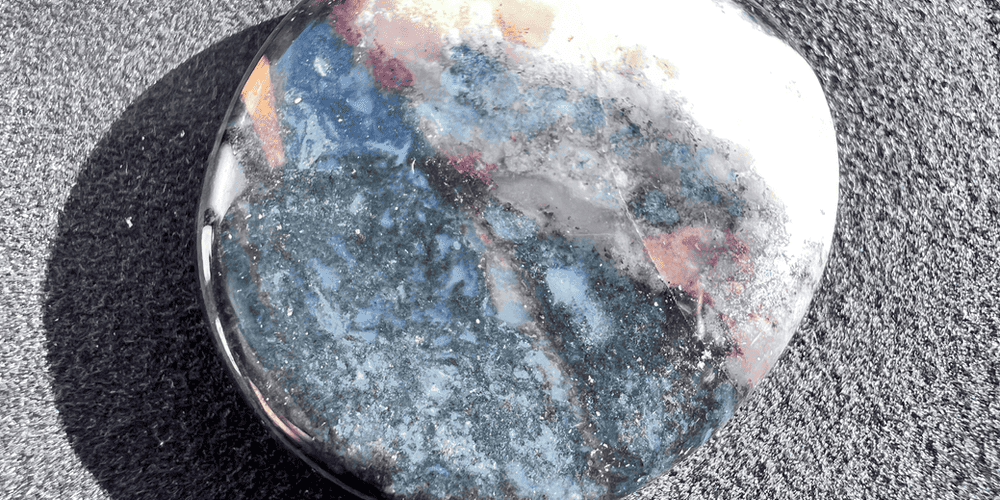Sardonyx: Properties, uses and virtues
Sardonyx: The Roman Stone of Courage
Sardonyx, is a variety of chalcedony, a form of quartz. It owes its fame to its warm colour, which varies from red-brown to orange-brown, evoking the hue of an aurora or sunset.
Sardonyx was prized for its aesthetic and symbolic properties, and played an important role in various ancient civilisations, from ancient Egypt to imperial Rome. It is often used to make jewellery and is appreciated for its protective and soothing properties.
In this article, we explore the origins, characteristics and meanings of sardonyx, a stone that has captivated mankind since time immemorial.

Sardonyx: Table of contents
- Geological Formation of Sardonyx
- Rough Sardonyx – Raw Beauty Revealed
- Sources – The Global Scope of Sardonyx
- Historical Significance of Sardonyx – Through the Ages
- Metaphysical properties of Sardonyx – Illuminating energies
- Varieties of Sardonyx
- Colors of Sardonyx
- Durability and Wearability of Sardonyx
- Improvements in Sardonyx – Preserving Natural Beauty
- Synthetic Sardonyx – Nature in the Laboratory
- Imitations of Sardonyx – Discerning the Authentic
- Sardonyx care – Preserving natural beauty
Geological Formation of Sardonyx
Sardonyx is a variety of chalcedony and quartz formed by the progressive deposition of mineral layers in cavities and cracks. Its captivating bands of colour, ranging from shades of red to brown and white, create a unique visual appeal that sets it apart from other gemstones.
Rough Sardonyx – Raw Beauty Revealed
Like chalcedony, sardony has a distinctive polycrystalline structure made up of microscopic crystals, which contributes to its bewitching appeal.
Sources – The Global Scope of Sardonyx
Sardonyx comes from various regions around the world, including Brazil, India, Germany and the United States. Each locality contributes to the unique blend of colors and patterns of this precious stone, making it a coveted choice for jewellery lovers.
Historical Significance of Sardonyx – Through the Ages
Throughout history, sardonyx has been of cultural and spiritual importance. From ancient civilisations to modern cultures, this multicoloured gemstone has adorned jewellery, talismans and ceremonial objects. Here are a few notable examples of sardony’s historical importance:
Ancient Rome :
Sardonyx was highly prized by the ancient Romans, who believed it could bring courage, strength and protection. Precious stones were often used to adorn cameos and intaglios, complex sculptures used for personal seals and ornaments.
Renaissance period :
Sardonyx enjoyed a resurgence in popularity during the Renaissance, symbolising power, bravery and virtue. It was often encrusted in seal rings and pendants, emphasising its aesthetic appeal and symbolic significance.
Modern use :
Today, sardonyx continues to be cherished as a significant gemstone. Its unique blend of colours is celebrated in a variety of jewellery pieces, from rings to pendants, reflecting individuality and personal style.
It is also adored as the traditional birthstone of August.
Metaphysical properties of Sardonyx – Illuminating energies
Sardonyx is associated with courage, protection and self-control. It is believed to boost inner strength, encourage willpower and provide a sense of stability. This precious stone is often used in spiritual practices to amplify positive energies and promote a balanced approach to life.
Varieties of Sardonyx
Sardonyx has no varieties.
Colors of Sardonyx
Sardonyx stones have a reddish to brown colour, often from sardite, with a distinct black, white or yellow marking. All other colors are obtained by dyes and treatments.
Durability and Wearability of Sardonyx
Sardonyx, with a hardness of 6.5-7 on the Mohs scale, is a durable gemstone suitable for many different types of jewellery. However, like all precious stones, it needs to be cared for properly to maintain its brilliance. Avoid exposing sardonyx to aggressive chemicals and store it separately to avoid scratches.
Improvements in Sardonyx – Preserving Natural Beauty
Natural sardonyx is not generally subject to improvements. However, some forms of sardonyx can be dyed to intensify or modify their colours. All colours other than those listed above are the result of dyes, imitations or errors in the naming of the stone. It is important to obtain stones from reliable sources to guarantee their authenticity.
Synthetic Sardonyx – Nature in the Laboratory
Synthetic sardonyx does not exist because of its complex geological formation and the accessibility of the stone.
Imitations of Sardonyx – Discerning the Authentic
To guarantee the authenticity of sardonyx stones, buyers should beware of imitations such as agate or tinted chalcedony, plastic, resins and other synthetic materials. It is advisable to buy from reliable sources and obtain appropriate certification.
Sardonyx care – Preserving natural beauty
To preserve the lasting appeal of sardonyx, gentle care is essential.
Clean sardonyx jewellery with a soft cloth and mild soapy water, and avoid exposing it to extreme temperatures or chemicals.
Proper care ensures that the gemstone’s vibrancy is preserved for generations to come.


Leave a Reply
Want to join the discussion?Feel free to contribute!